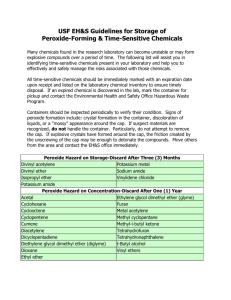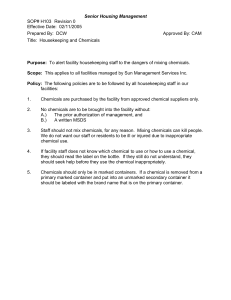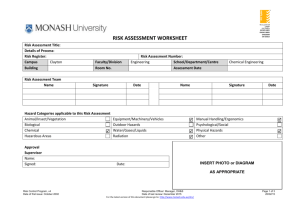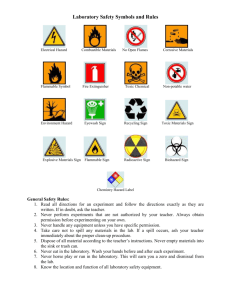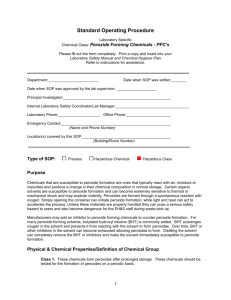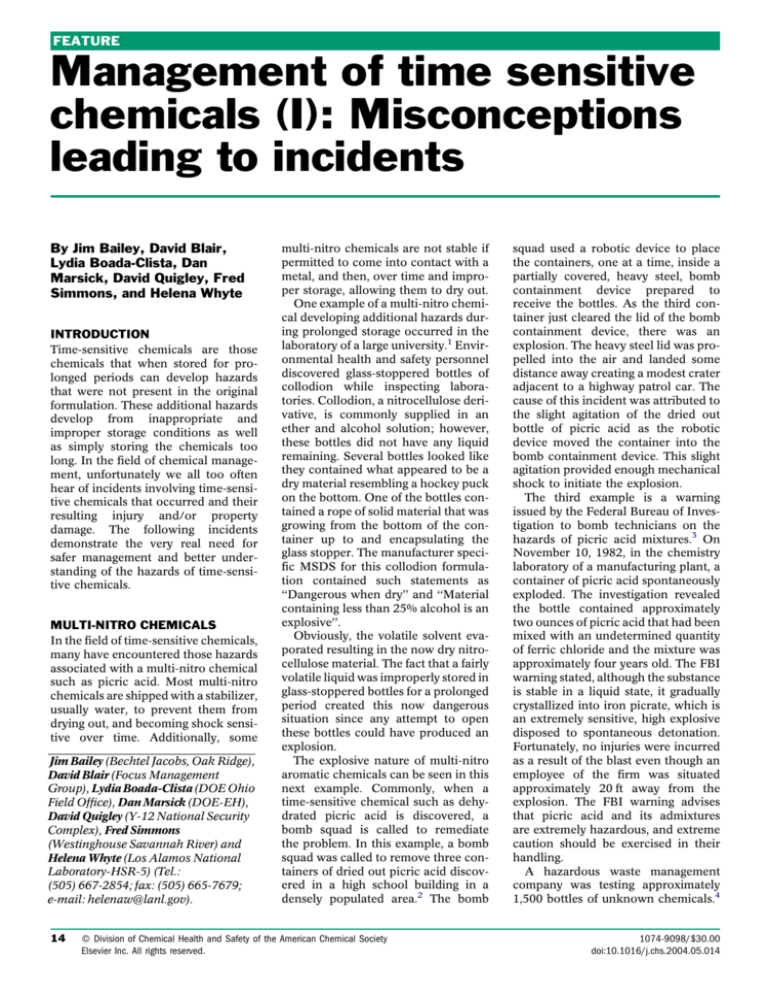
FEATURE
Management of time sensitive
chemicals (I): Misconceptions
leading to incidents
By Jim Bailey, David Blair,
Lydia Boada-Clista, Dan
Marsick, David Quigley, Fred
Simmons, and Helena Whyte
INTRODUCTION
Time-sensitive chemicals are those
chemicals that when stored for prolonged periods can develop hazards
that were not present in the original
formulation. These additional hazards
develop from inappropriate and
improper storage conditions as well
as simply storing the chemicals too
long. In the field of chemical management, unfortunately we all too often
hear of incidents involving time-sensitive chemicals that occurred and their
resulting injury and/or property
damage. The following incidents
demonstrate the very real need for
safer management and better understanding of the hazards of time-sensitive chemicals.
MULTI-NITRO CHEMICALS
In the field of time-sensitive chemicals,
many have encountered those hazards
associated with a multi-nitro chemical
such as picric acid. Most multi-nitro
chemicals are shipped with a stabilizer,
usually water, to prevent them from
drying out, and becoming shock sensitive over time. Additionally, some
Jim Bailey (Bechtel Jacobs, Oak Ridge),
David Blair (Focus Management
Group), Lydia Boada-Clista (DOE Ohio
Field Office), Dan Marsick (DOE-EH),
David Quigley (Y-12 National Security
Complex), Fred Simmons
(Westinghouse Savannah River) and
Helena Whyte (Los Alamos National
Laboratory-HSR-5) (Tel.:
(505) 667-2854; fax: (505) 665-7679;
e-mail: helenaw@lanl.gov).
14
multi-nitro chemicals are not stable if
permitted to come into contact with a
metal, and then, over time and improper storage, allowing them to dry out.
One example of a multi-nitro chemical developing additional hazards during prolonged storage occurred in the
laboratory of a large university.1 Environmental health and safety personnel
discovered glass-stoppered bottles of
collodion while inspecting laboratories. Collodion, a nitrocellulose derivative, is commonly supplied in an
ether and alcohol solution; however,
these bottles did not have any liquid
remaining. Several bottles looked like
they contained what appeared to be a
dry material resembling a hockey puck
on the bottom. One of the bottles contained a rope of solid material that was
growing from the bottom of the container up to and encapsulating the
glass stopper. The manufacturer specific MSDS for this collodion formulation contained such statements as
‘‘Dangerous when dry’’ and ‘‘Material
containing less than 25% alcohol is an
explosive’’.
Obviously, the volatile solvent evaporated resulting in the now dry nitrocellulose material. The fact that a fairly
volatile liquid was improperly stored in
glass-stoppered bottles for a prolonged
period created this now dangerous
situation since any attempt to open
these bottles could have produced an
explosion.
The explosive nature of multi-nitro
aromatic chemicals can be seen in this
next example. Commonly, when a
time-sensitive chemical such as dehydrated picric acid is discovered, a
bomb squad is called to remediate
the problem. In this example, a bomb
squad was called to remove three containers of dried out picric acid discovered in a high school building in a
densely populated area.2 The bomb
ß Division of Chemical Health and Safety of the American Chemical Society
Elsevier Inc. All rights reserved.
squad used a robotic device to place
the containers, one at a time, inside a
partially covered, heavy steel, bomb
containment device prepared to
receive the bottles. As the third container just cleared the lid of the bomb
containment device, there was an
explosion. The heavy steel lid was propelled into the air and landed some
distance away creating a modest crater
adjacent to a highway patrol car. The
cause of this incident was attributed to
the slight agitation of the dried out
bottle of picric acid as the robotic
device moved the container into the
bomb containment device. This slight
agitation provided enough mechanical
shock to initiate the explosion.
The third example is a warning
issued by the Federal Bureau of Investigation to bomb technicians on the
hazards of picric acid mixtures.3 On
November 10, 1982, in the chemistry
laboratory of a manufacturing plant, a
container of picric acid spontaneously
exploded. The investigation revealed
the bottle contained approximately
two ounces of picric acid that had been
mixed with an undetermined quantity
of ferric chloride and the mixture was
approximately four years old. The FBI
warning stated, although the substance
is stable in a liquid state, it gradually
crystallized into iron picrate, which is
an extremely sensitive, high explosive
disposed to spontaneous detonation.
Fortunately, no injuries were incurred
as a result of the blast even though an
employee of the firm was situated
approximately 20 ft away from the
explosion. The FBI warning advises
that picric acid and its admixtures
are extremely hazardous, and extreme
caution should be exercised in their
handling.
A hazardous waste management
company was testing approximately
1,500 bottles of unknown chemicals.4
1074-9098/$30.00
doi:10.1016/j.chs.2004.05.014
Prior to conducting standard hazardous characterization tests, chemical
technicians were opening each container by simply twisting off the lids.
One of the containers was a small, dark
green, glass bottle with a rusty metal
lid. The lid could not easily be removed
so a pair of channel lock pliers was
obtained. As the lid began to move
with the use of the pliers, there was
an immediate explosion. Glass shards
embedded in a nearby chair were covered with a light yellow powder; infrared analysis indicated the material was
picric acid. The combination of picric
acid and the metal lid resulted in the
formation of metal picrates that, over
time, dried out in the threads of the
container. Friction from twisting the
lid initiated the explosion. From a chemical management perspective, this incident is important for two reasons. First,
care needs to be exercised in safely
accessing the contents of containers
that have been stored for prolonged
periods. Secondly, when a researcher
leaves a laboratory, the chemicals
should be inventoried with a particular
emphasis on safe management of timesensitive chemicals present.
PEROXIDE FORMING
CHEMICALS
Of the time-sensitive chemical situations most commonly encountered,
peroxide forming chemicals seem to
attract the most attention as can be
shown by the number of published
incidents.5–8 As the following incidents illustrate, there are some common misconceptions that can create a
particularly hazardous situation if peroxide forming, time-sensitive chemicals are improperly managed.
An incident occurred involving an
‘‘empty’’ ether can found in a laboratory trashcan.9 A common misconception is that old, ‘‘empty’’ ether cans do
not present a hazard. A technician
collected the empty ether can in a pail
with other items and transported it to a
chemical fume hood in the hazardous
waste storage facility. The following
week a specialized chemical management team arrived to stabilize containers of time-sensitive chemicals. The
technician remotely accessed the
empty, metal can and introduced a
dilute ferrous salt solution. As soon
as the liquid entered the metal can,
there was an explosion, and the metal
can disappeared into many small
pieces. A large fireball was observed
exiting the top, front of the chemical
fume hood. The cause of the incident
was believed to be the reaction of peroxide crystals in the ‘‘empty’’ ether can
with the mild reducing agent that was
added.
Another common situation involved
the proper disposal of older ‘‘Squibb’’
cans of ethyl ether. A previously
opened, old ‘‘Squibb’’ can of anesthesia grade ethyl ether that contained
approximately 4% ethyl alcohol as an
inhibitor was being stabilized.9
Because the inhibitor was thought to
be present, this container of ether was
not viewed as particularly hazardous.
After remotely accessing the small
metal can, an aliquot was withdrawn
for application to a peroxide test
strip. Since the liquid level was low,
the can was tilted and a pipette
extended into the liquid. After applying
the liquid to the test strip, color developed representing a concentration of
approximately 50-ppm peroxides. As
the can was up righted, there was an
immediate explosion resulting in a fireball that filled the fume hood. Cause of
the incident was believed to be the
formation of peroxide crystals in the
top portion of the can. The slight handling of the metal can during the testing
was enough mechanical shock to produce the explosion.
A nice shiny, metal can of ether is
rarely viewed as potentially dangerous.
Two nice, shiny cans of ether that had
been continually used for four months,
and subsequently stored for eighteen
months, were to be tested for peroxides.10 The containers were observed
to be one third full and tests indicated
the liquid contained over 100 ppm.
peroxides. After chemically reducing
all measurable peroxides using a ferrous salt solution, each can was
inverted to wet all inside metal surfaces. Each solution was retested,
and again found to have greater than
100 ppm peroxides. It was thought that
the inverting of each can caused the
dissolution of peroxide crystals located
in the upper inside surfaces of the can.
This incident illustrates how the out-
Chemical Health & Safety, September/October 2004
ward appearance (e.g., a new, shiny
looking metal can) does not necessarily indicate a safe situation.
Another frequently encountered
misconception is that refrigeration will
stabilize the time-sensitive chemicals.
A specialized chemical management
team was sent to remediate numerous
containers of peroxide forming chemicals stored in a walk-in refrigerator.9
Because of unusual safety considerations, it was decided that the stabilization work take place outside a door at
the end of the rather long hallway. One
at a time, each of two, old rusty cans of
ethyl ether were put into separate pails
containing vermiculite for cushioning
and hand carried down the hallway
toward the exit door. About 15 paces
down the hallway, one of the cans
exploded. The cause of this incident
was believed to be the formation of
solid peroxide crystals in the metal
can of ether. It was thought that the
change in temperature provided
enough physical stress on the solid
peroxide crystal structures to initiate
the explosion. The effectiveness of the
inhibitor during refrigeration of a peroxide former will be discussed in a
subsequent article.
It is commonly thought that measuring peroxide concentrations in solution using dip strips or other
methods is accurate when this may
not necessarily be the case. While stabilizing a container of sec-butyl alcohol over 20 years old, the initial
peroxide test showed 30 ppm.11 To
chemically reduce the peroxides, a
dilute ferrous salt solution was added,
and the alcohol retested. After the
addition of the reduction agent, the
test strip indicated a peroxide concentration much greater than 100 ppm.
The chemical seemed to be producing
peroxides. Testing of other, old, shortchained alcohols in the three to eight
carbon range produced similar
results.12 It was thought that this was
due to the formation of polyperoxides
which the test strips could not measure.
The polyperoxides may represent
additional hazards when present in
different solvents such as tetrahydrofuran (THF). For example, a glass container of THF approximately 14 years
old was remotely accessed for stabili15
zation.13 A thermocouple device was
attached to the side of the container.
The peroxide concentration was measured at 10 ppm and this low concentration of peroxides did not seem to
present any safety concern. No temperature change was observed during
the neutralization of the peroxides
using a dilute ferrous salt solution. A
hydroquinone/ethanol solution was
prepared and added to the container
to inhibit the further formation of peroxides. Almost immediately the solution temperature rapidly increased.
The THF container was placed in a
previously prepared ice bath and the
thermocouple relocated to the top of
the bottle. The temperature at the top
of the container increased to 136 8F,
and remained there for at least twenty
minutes. There was a serious risk of fire
and explosion had the ice bath not
been available. Similar behavior was
observed in other efforts to stabilize
THF.13
MATERIALS THAT GENERATE
ADDITIONAL HAZARDS OVER
TIME
Chloroform should be treated as a
time-sensitive chemical especially if it
is not stabilized or is stabilized with
amylene. In 1998, four students at the
University of California, Los Angeles,
were mildly poisoned by phosgene
after using chloroform that had been
stored at room temperature for three
years in a brown glass bottle.14 Analysis of the container showed phosgene
concentrations of 11,000 ppm in the
liquid, and 15,000 ppm in the vapor
space above it.
GENERATION OF TIMESENSITIVE METAL FULMINATES
A commonly used characterization
test for aldehydes requires Tollen’s
reagent which is a solution containing
silver nitrate, dilute sodium hydroxide,
and ammonium hydroxide. Tollen’s
reagent solution, if stored for too long,
can become unstable and explosive.
An explosion occurred as a student
put a pipette into a storage bottle of
Tollen’s reagent that was not freshly
prepared.15 Several students were hospitalized with eye injuries as a result of
16
Figure 1. Calcium carbide stored in a glass container with a high brass content
metal lid. Note the bulging lid indicating acetylene gas inside the container.
the explosion that sprayed the students
with glass and the caustic Tollen’s
reagent. A contributing factor in this
instance was that an excess amount of
Tollen’s reagent was prepared and
stored for future use in this and subsequent experiments.
HEAVY METAL ACETYLIDES
FORMATION
A commonly made error is to store
chemicals in containers that are
incompatible for long-term storage.
Figure 1 shows calcium carbide stored
in a glass container with a bulging
metal lid.16 The screw on lid present
on this container was manufactured
from metal with a high brass content.
Upon prolonged storage, the calcium
carbide reacted with moisture in the air
to produce acetylene gas. The acetylene gas reacted with copper and other
heavy metals present in the high brass
content lid. The product of this reaction was heavy metal acetylides which
were now located in the threads of the
cap. Heavy metal acetylides of this type
are extremely unstable and are prone
to explosion. Simply the act of twisting
the lid or bumping the container could
provide enough energy to initiate an
explosion.
TIME-SENSITIVE ISSUES AND
GAS CYLINDERS
Another example of a chemical that
is incompatible with its container
over prolonged storage is anhydrous
hydrogen fluoride (AHF). Anhydrous
hydrogen fluoride is a colorless, corrosive and toxic liquid normally packaged in mild steel cylinders under
its own vapor pressure of 2.1 kPa
(0.3 psig.) at 20 8C. AHF over time
will react with the mild steel of the
cylinder to produce hydrogen which
is a nonliquefiable gas. The build up
of hydrogen gas will cause the pressure
inside the cylinder to increase. Numerous incidents have been reported of
sudden failure of AHF gas cylinders
due to over pressurization.17 This
usually occurs with AHF that has been
in storage over a long period of time,
typically for 15–25 years. If this over
pressurization occurs in a cylinder
with a pressure relief device, then the
pressure relief device will actuate and
allow the contents of the cylinder to be
released. If no pressure relief device
is present, such as on lecture bottles,
then the over pressurization can result
in the catastrophic failure of the cylinder (Figure 2). One lecture bottle
of AHF stored for 14 years developed
an estimated pressure of 2,400 psig.
that was in excess of the nominal
1,800 psig. cylinder pressure rating. A
similar situation was recently reported
in which anhydrous hydrogen bromide
(AHBR) was stored for long periods
of time in lecture bottle cylinders.18
Some of these lecture bottles of AHBR
were found with pressures that, again,
exceeded the 1,800 psig. pressure rating of the cylinder. No instances could
Chemical Health & Safety, September/October 2004
Figure 2. Anhydrous hydrogen fluoride cylinder, before and after catastrophic
failure. Note how the failure has resulted in fragmentation of the cylinder.
be found involving anhydrous hydrogen chloride cylinder over pressurizations.
A unique problem observed to occur
with older gas cylinders containing
corrosive gases involves valve degradation or the safety relief device. Many of
these cylinders have been found with
inoperable valves that will not release
gas when the valve wheel is turned to
open the valve. Another hazard is that
attempts to open the valve can result in
the entire valve stem being ejected
from the valve body.19 Prolonged storage of corrosive gases in gas cylinders
can corrode pressure relief devices
causing them to fail. Failure of the
pressure relief device or ejection of
the valve stem (Figure 3) will allow
Figure 3. Valve degradation with anhydrous hydrogen bromide. The hole on
the left has corroded over time. An
original valve is on the right.
the entire contents of the gas cylinder
to be released. Cylinders containing
corrosive gases should be very carefully managed.
CONCLUSION
Several issues have been described in
this paper. First, time-sensitive chemicals continue to be stored for so long
that additional hazards are created
that can put workers at increased risk.
Second, workers many times do not
realize that these materials have additional risks present which makes them
even more dangerous. Third, the
chemistry and management of timesensitive chemicals is not well understood. Lastly, it appears that, when a
time-sensitive chemical is stored too
long and discovered, workers are
unsure of how to safely mitigate or
dispose of them. What is needed is a
better understanding of the chemistry
of time-sensitive chemicals, proper
management techniques to control
them, and appropriate procedures
and properly trained personnel to mitigate aged time-sensitive chemicals
when they are discovered. These
topics will be discussed in subsequent
papers.
References
1. Work performed by David E. Blair and
James F. Ward, January 2000.
Chemical Health & Safety, September/October 2004
2. Personal communication from Ted
Morris, HazMat Fireman, and David
E. Blair, June 1999.
3. United States Department of Justice,
Federal Bureau of Investigation, Bomb
Data Center, Technical Bulletin Dated
November 10, 1982, Warning: Picric
Acid – San Mateo County, California,
Washington, DC.
4. Personal communication from Mike
O’Donnell to David E. Blair, December 2002.
5. Kelly, R. J. Review of safety guidelines
for peroxidizable organic chemicals.
Chem. Health Safe. 1996, 3(5), 27–
36.
6. Clark, D.E. Peroxides and peroxide—
forming compounds. Chem. Health
Safe. 2001, 8(5), 12–22.
7. Steere, Norman V. Control of hazards
from peroxides in ethers. J. Chem. Ed.,
1964, 41(8).
8. Davies, Alwyn G. Explosion hazards
of autoxidized solvents. J. R. Inst.
Chem., 80, 386–9.
9. Personal communication from Rick
Brannon to David E. Blair, October
1991.
10. Work performed by David E. Blair
and Raymond Meyers, December
1998.
11. Work performed by Kevin Meyers and
David E. Blair, September 2000.
12. Work performed by James Ward, Ray
Meyers, and David E. Blair, January
2000.
13. Work performed by James Ward,
Ray Meyers and David E. Blair, April
2000.
14. Turk, E. Chem. Eng. News 1998, 76(9),
6.
15. BBC News Article, Published 07/
21/2003, http://news.bbc.co.uk/go/
pr/fr/-/2/hi/uk_news/england/tyne/
wear/3083899.stm
16. Presented by Christopher L. Erzinger,
Colorado Department of Public
Health, at the College and University
Environmental Conference, August
2003.
17. Princiotto, Laurie A. lprincio@
INDIANA.EDU, Hydrogen Fluoride
Cylinder Ruptures. Laboratory Safety
Specialist, Indiana University, Department of Environmental Health and
Safety,
Creative
Arts
Building,
Bloomington,
IN
47408-2602,
http:www.ehs.indiana.edu
18. SET Environmental, Inc., Hydrogen
Bromide Safety Advisory, Houston,
TX, January 23, 2003.
19. Personal communication from Chris
Meeks to David E. Blair, June 2001.
17

